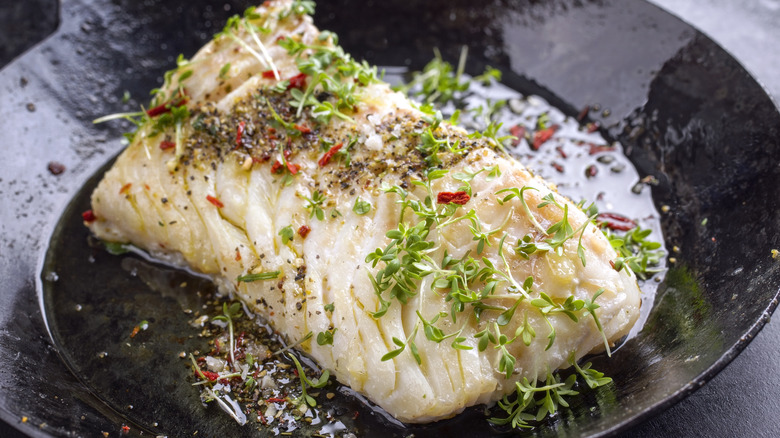Use This Richard Blais-Approved Hack For A Better Sear And Crust On Fish - Exclusive
Your initiation into the world of state-of-the-art fish cookery starts now. Achieving a perfect sear and crust on fish is a two-part process that starts before the fish hits the pan. Say what? The pre-pan process might be as important as what you do to the fish after it comes in contact with heat. Take it from Richard Blais. Blais — for some context — is no seafood stranger. He not only won "Top Chef: All-Stars" with a surf and turf-inspired menu, his Florida restaurant, Four Flamingos – with locations in Orlando and Key West — celebrates seafood like it's no one's business.
In an exclusive interview with Tasting Table, Blais said that when purchasing a fish, you want it "slick" and "shimmery" for optimal freshness. While moisture is a good sign when selecting seafood at the market, it isn't when prepping your fish for heat. Blais explained, "Whether it's meat or fish a dry surface into a hot pan is going to get a better sear or a better crust on it." To achieve a pan-ready fish, the "Next Level Chef" mentor suggests patting the skin of your fish down with a paper towel. You're not done yet. "Some chefs have said, 'Use a squeegee on it,'" the celebrity chef elaborated. No need for special tools though, according to Blais. Make sure your fish is truly primed for cooking by using the back of your knife to scrape off "the extra moisture on the fish's skin."
How to make sure your pan is fish-ready
You've patted down your fish with a paper towel and scraped off excess moisture with the back of your knife. Your fish is now pan-ready. But is your pan fish-ready? You can forget a perfect sear and crust if your fish sticks to the pan when you cook it. If that happens, the likely culprit is your pan. The fix — praise be to the fish gods — couldn't be simpler. No matter the level of heat your recipe calls for, Richard Blais advised Tasting Table that it's best to get your pan piping hot before adjusting the stovetop dial. "You want the pan to get hot enough so that the fish doesn't stick," the chef cautioned.
As per Blais, you'll know your pan is properly prepped for its seafood meal when you "see a little bit of smoke in the oil or clarified butter," that you're using to cook it in. (Blais himself prefers clarified butter.) When you see smoke, turn down the heat to your desired cooking temperature and, voilá. Conditions are now optimal for a perfect sear.

